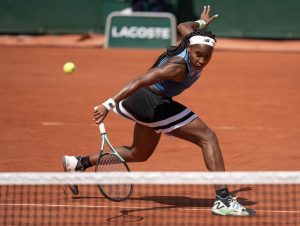So shocking was Serena Williams’s collapse against Karolina Pliskova at the Australian Open, from being 5-1 up in the third set to losing it 7-5, that it is still hard to believe that it really happened. And yet Serena is not the first tennis superstar to somehow snatch ignominious defeat from the jaws of apparently certain victory.
Here are the five worst collapses in tennis history.
-
SERENA WILLIAMS AGAINST KAROLINA PLISKOVA IN THE 2019 AUSTRALIAN OPEN QUARTERFINAL
Serena Williams’s stunning loss this week immediately merits inclusion in any list of all-time tennis collapses. Of course, that is principally due to the fact that for so much of her career Serena has appeared almost invincible on court, so prodigious are her talents. And yet against Karolina Pliskova she reminded us that for all the apparent godliness of her tennis, she too is merely human.
There were also several mitigating factors in this particular loss. The first and most obvious one was that, having been foot-faulted as she struck what appeared to be the match-winning serve, Serena injured her ankle on the very next point. The day after the match, her coach, Patrick Mouratoglu, claimed that she had known instantly that even if she had somehow won through against Pliskova, she would have been unable to compete in the semifinal and so, subconsciously or otherwise, she had effectively accepted defeat as inevitable.
The other possible mitigating factor that many commentators and writers referred to afterwards (indeed, the BBC commentator, Mark Petchey, mentioned it during the match) was that Serena may have been trying to overcompensate for her meltdown in New York last September, when she had railed so angrily against being penalised a point for receiving coaching from Mouratoglou during the US Open final against Naomi Osaka. Perhaps because she had been so roundly condemned for over-reacting then, she under-reacted, as it were, in Melbourne when the match began to go against her, rather than summoning her customary fighting spirit to see off Plistova before the Czech could fully fight her way back.
Of course, as Serena herself said, one should not forget Pliskova’s own performance, which was indeed a case of playing “lights out” tennis when she was staring defeat in the face. Nevertheless, notwithstanding Pliskova’s brilliance, it is much more likely that Serena is experiencing what so many women (indeed, almost all women) experience after giving birth, namely that things have changed completely. When Serena took time off the tour to have her daughter, she was utterly dominant, having defeated her sister, Venus, in the 2017 Australian Open Final when she was already several weeks pregnant. Now that she is a mother, with all the mental and physical transformation that that entails, it might ultimately prove impossible for her to get back to her best.
-
JOHN McENROE AGAINST IVAN LENDL IN THE 1984 FRENCH OPEN FINAL
Even the great and greatly combative John McEnroe was not immune to the occasional spectacular cave-in on court, as he demonstrated against Ivan Lendl in the 1984 French Open Men’s Singles final. At the time, McEnroe seemed scarcely less invincible than Serena Williams had appeared prior to her collapse against Karolina Pliskova, and yet he, too, succumbed to the sporting equivalent of falling down five flights of stairs.
Going into that final in May 1984, McEnroe had been playing not only the greatest tennis of his career but arguably the greatest tennis of anybody’s career up to that point. Contrary to George Orwell’s predictions, 1984 was McEnroe’s annus mirabilis as he played serve-and-volley at a level unseen since the late sixties hey-day of the great Rod Laver, McEnroe’s own personal idol, and given that the widespread introduction of non-wooden rackets within a few years would eventually effectively kill off serve-and-volley, such instinctive net-rushing may never be seen again. It appeared inevitable that McEnroe would win the French Open for the first time, in the process becoming the first American to do so since Tony Trabert in 1955, especially as his opponent that day in 1984, Ivan Lendl, had already lost his first four Grand Slam Finals.
McEnroe was not necessarily consumed by nerves in 1984 so much as he was lulled into a false sense of security by his own brilliance. And once the tide began to turn, as Lendl won the third set, McEnroe discovered, like King Canute before him, that it is impossible to turn back. Lendl won the final three sets and McEnroe suffered the most agonising defeat of his career – yes, one even worse than losing the great Wimbledon final against Bjorn Borg in 1980. He would gain his revenge on Borg at Wimbledon the following year, but he would never win the French Open.
-
GUILLERMO CORIA AGAINST GASTON GAUDIO IN THE 2004 FRENCH OPEN FINAL
There are numerous contenders to win the utterly uncoveted title of “Best Man Never To Win A Major,” from Miloslav Mečíř to Tim Henman to (it would appear) Grigor Dimitrov, but one of the main contenders would have to be Argentina’s Guillermo Coria. In fact, to be more precise, Coria might just be the greatest clay-court player never to have won the French Open and, worse still, he didn’t so much lose the 2004 French Open Final against his fellow countryman, Gaston Gaudio, as surrender it to him.
Between the decline of Gustavo Kuerten, who won three French Opens around the turn of the millennium, and the rise of Rafael Nadal, who will almost certainly be the favourite to win an astonishing 12th title at Roland Garros when the 2019 tournament starts in May, Guillermo Coria was probably the best male clay-court player in the world. He demonstrated that thrillingly in his semifinal, when he beat Tim Henman. Admittedly, Henman was not a clay-court specialist, but at the time he was still a highly ranked player. Nevertheless, Coria beat Henman in four sets, which included bagelling the Englishman 6-0 in the third set. And when Coria repeated the trick by bagelling Gaston Gaudio, something of a journeyman who had astounded everyone by reaching the final, in the first set of the final, it appeared certain that Coria would finally be crowned the King of Clay.
Of course nothing of the sort happened. Although Coria went on to win the second set and even served for the match, Gaudio ultimately showed that he was the Argentine with the mettle of a Major-winner, as he fought back from what appeared to be certain defeat to win 8-6 in the fifth set. Poor Coria never recovered, and never again reached another Major final.
-
MIKAEL PERNFORS AGAINST JIMMY CONNORS IN THE FOURTH ROUND AT WIMBLEDON IN 1987
In many ways, Mikael Pernfors is the forgotten man of Swedish tennis. He was good enough to reach the French Open Final in 1986 (which he lost in straight sets to Ivan Lendl) but unlike Borg, Wilander and Edberg he was not quite good enough to win a Major. What makes things worse is that if Pernfors is remembered at all today, it is for the worst defeat of his career, an astonishing collapse against Jimmy Connors in the fourth round at Wimbledon in 1987.
The figures alone convey the extent to which Pernfors initially dominated the ageing Connors that day. He won the first two sets 6-1 and appeared to be continuing in that vein when he broke Connors again (for what seemed to be the umpteenth time in the match) to take an apparently unlosable 4-1 lead in the third set. And yet lose he did.
Perhaps more than any other match in his long and “storied” career, the comeback by Connors against Pernfors cemented his reputation as arguably the fiercest competitor ever to play tennis – a man who, whatever he lacked in pure technical ability or aesthetics, he more than made up for in fighting spirit, if not downright cussedness. As if realising that he had nothing left to lose as he approached the end of the third set (and, it appeared, the end of the match), Connors suddenly began swinging and for the first time in the match his balls began to find the lines.
Riding a wave of pure adrenaline, and milking the support of the Centre Court crowd who (like tennis fans everywhere) simply longed to see as much tennis as they possibly could, Connors fought back to win in five sets. In the process, he began the last great phase of his long and successful career, which culminated in a run to the US Open semifinal in 1991, when he was nearly 40 years old. As for poor old Pernfors, he never truly recovered from that defeat and eventually had to settle for the unwanted status of being a largely forgotten figure who everyone could remember one thing about.
-
JANA NOVOTNA VERSUS STEFFI GRAF IN THE 1993 WIMBLEDON WOMEN’S SINGLES FINAL
Like almost every other tennis player, Serena Williams hates to use the term “choke,” the damning word that is usually employed when a player somehow loses a match they appeared certain to win. It conveys the sense that they had lost their nerve, or more accurately been overwhelmed by nerves. That is why I use the term “collapse” for all of these historic defeats, because I think it is more accurate. A player, even a great one like Serena or John McEnroe, somehow suddenly loses their sense of sure-footedness, their opponent reacts and the tables are duly turned. However, if the term “choke” could ever be legitimately used, it is in relation to Jana Novotna’s astonishing defeat in the 1993 Wimbledon Women’s Singles final against Steffi Graf.
The truly remarkable story of Jana Novotna was, tragically, retold relatively recently when she died of cancer in November 2017 at the age of only 49. THAT was a genuine tragedy, a life tragedy, rather than the sporting equivalent of one that she had experienced against Graf more than 20 years earlier. Then, she somehow surrendered a 4-1 lead in the third set to lose the next six games and with them the title, before literally collapsing in tears on the shoulder of the minor royal who was there to hand out the prizes. (My republican tendencies compel me to forget her exact title.)
And yet what is most remarkable about Novotna’s story, at least on the tennis court, is that it ultimately ended happily. She came back five years later to finally win the Wimbledon title that she had somehow lost in 1993. In the process, she proved that one man or woman’s collapse, or even choke, is another man or woman’s comeback. And in the case of Jana Novotna, ultimately she herself was the woman who came back, against all the odds, to win the Major title that her talent and, more importantly, her fighting spirit undoubtedly deserved.
Main Photo:
Embed from Getty Images






